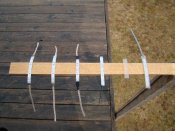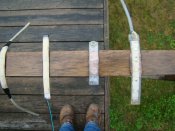Bill Ellick
Full time elf
- Thread starter
- #16
Well Thanks to Jeff Millard for donating some silicone tubing covering to the cause, I now have 2 pieces of it out in the weather for testing.
Today is the 2 week mark for the RGB strips that I put out originally. I added the 2 pieces of silicone tubing last night inside so the silicone adhesive could set up and just put the test setup back outdoors this morning.
The silicone strips I made up one with a piece of dumb strip inside it with wires soldered on and the ends of the silicone tubing sealed. The other piece of tubing is empty with one end sealed to prevent the wind from blowing though the piece although I want some air to be able to circulate into it.
Nothing to report so far on the test other than some very light either oxidation or else it is the flux remanents discoloring on the one strip that I soldered 2 wires on but has no protection on the solder joints. The 2 adjacent copper pads are bright and shiny which makes me think that this is more the flux degrading than actual corrosion of the solder, but it really is too early to tell at this point.
The weather for the past 2 weeks has been pretty much overcast with rainy and snowy periods with the temps ranging from low 20's at night to mid 40's during the day. Of course these are F and not C so those folks who live in Aus or Can will have to forgive me and convert for themselves. Guess I better get a dual reading thermometer on the next shopping trip and post it on the photos for you!
So the waiting and watching will continue for months and we shall see what we shall see!
I have also begun contacting manufacturers of sealants and hot melt adhesive (HMA or hot glue if you like) to get the actual data sheets on the sealants as well as any recommendations on useage of these substances on electronic and electrical connections.
This way the testing will have actual "factory specs" to base the results on and not my own personal opinion or observations which only seems like the right way to do this.
Today is the 2 week mark for the RGB strips that I put out originally. I added the 2 pieces of silicone tubing last night inside so the silicone adhesive could set up and just put the test setup back outdoors this morning.
The silicone strips I made up one with a piece of dumb strip inside it with wires soldered on and the ends of the silicone tubing sealed. The other piece of tubing is empty with one end sealed to prevent the wind from blowing though the piece although I want some air to be able to circulate into it.
Nothing to report so far on the test other than some very light either oxidation or else it is the flux remanents discoloring on the one strip that I soldered 2 wires on but has no protection on the solder joints. The 2 adjacent copper pads are bright and shiny which makes me think that this is more the flux degrading than actual corrosion of the solder, but it really is too early to tell at this point.
The weather for the past 2 weeks has been pretty much overcast with rainy and snowy periods with the temps ranging from low 20's at night to mid 40's during the day. Of course these are F and not C so those folks who live in Aus or Can will have to forgive me and convert for themselves. Guess I better get a dual reading thermometer on the next shopping trip and post it on the photos for you!
So the waiting and watching will continue for months and we shall see what we shall see!
I have also begun contacting manufacturers of sealants and hot melt adhesive (HMA or hot glue if you like) to get the actual data sheets on the sealants as well as any recommendations on useage of these substances on electronic and electrical connections.
This way the testing will have actual "factory specs" to base the results on and not my own personal opinion or observations which only seems like the right way to do this.








